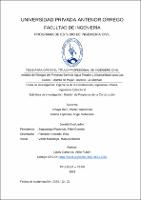Análisis de Riesgos del Proyecto Servicio Agua Potable y Alcantarillado para Las Dunas I, distrito de Paiján, Ascope, La Libertad

Fecha
2024Autor(es)
Amaya Haro, Paolo Franccesco
Urbina Espinoza, Ángel Sebastián
Metadatos
Mostrar el registro completo del ítemResumen
La presente investigación tuvo como objetivo implementar la gestión de riesgos en el proyecto de servicio agua potable y alcantarillado para las Dunas I, distrito de Paiján, Ascope, La Llibertad”, Se utilizó la metodología de gestión de riesgos basado en los lineamientos de la guía PMBOK sexta edición.
Inicia con las generalidades del proyecto donde se mencionan las características esenciales para el desarrollo de la investigación. Luego, el proceso de la gestión de riesgos fue determinado por los siguientes pasos: Planificación de la gestión de riesgos donde fue definido las actividades e información que va a ser útil en el análisis, identificación de los 69 riesgos mediante herramientas, técnicas y documentación, pudiendo así encontrar los riesgos individuales que afectan al proyecto, análisis cualitativo de los riesgos donde se analizaron los niveles de priorización de cada riesgo individual, análisis cuantitativo de los riesgos aplicando el análisis de Monte Carlo a través del Software @RISK V.8.2. permitiendo elaborar un estudio más preciso y productivo y la planificación de respuesta a los riesgos.
Finalmente, se propusieron medidas preventivas o de mitigación contra los riesgos identificados a través de una matriz organizada de acuerdo a su magnitud y complejidad que se puedan presentar en las diversas fases del proyecto The objective of this research was to implement risk management in the drinking water and sewerage service project for Las Dunas I, district of Paiján, Ascope, La Libertad. The risk management methodology based on the guidelines of the PMBOK sixth edition guide was used.
It begins with the generalities of the project where the essential characteristics for the development of the investigation are mentioned. Then, the risk management process was determined by the following steps: Risk management planning where it was defined the activities and information that will be useful in the analysis, identification of the 69 risks through tools, techniques and documentation, thus being able to find the individual risks that affect the project, qualitative analysis of the risks where the prioritization levels of each individual risk were analyzed, quantitative analysis of the risks applying Monte Carlo analysis through the @RISK V.8.2. software allowing to elaborate a more accurate and productive study and the planning of response to the risks.
Finally, preventive or mitigation measures against the identified risks were proposed through a matrix organized according to their magnitude and complexity that may occur in the various phases of the project
Palabras clave
Colecciones
- Ingeniería Civil [1391]

